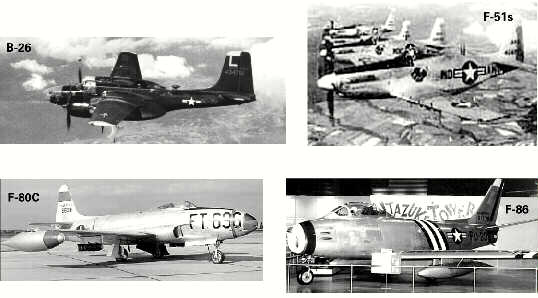This article was originally published on the Department of Defense 50th Anniversary of the Korean War Commemoration website. Unfortunately that website is no longer accessible.
Back to Fact Sheets Overview Page
There were 131 Medals of Honor awarded to U. S. servicemen for their actions during the Korean War. Four of these were given posthumously to members of the United States Air Force (USAF).
Major Louis J. Sebille
The first Air Force aviator to receive the Medal of Honor was Major Louis J. Sebille, an F-51 pilot and commander of the 67th Fighter-Bomber Squadron. On August 5, 1950, Sebille led a flight of F-51 Mustangs against communist artillery and troop positions concentrated on the banks of a river near Hamchang, South Korea.
On his first attack, one of Sebille’s 500-pound bombs would not release and he made a second run on the target. His plane was heavily damaged by enemy fire on this pass. Despite entreaties by his comrades to return to base, Sebille made another strafing run on the enemy positions.
During this run, his plane sustained additional damage. Realizing that the enemy fire had mortally damaged his aircraft, Sebille deliberately flew his Mustang into the communist positions. On Aug. 24, 1951, at March Air Force Base (AFB), Calif., Air Force Chief of Staff General Hoyt S. Vandenberg presented the Medal of Honor to Sebille’s widow.
Captain John S. Walmsley, Jr.
The exploits of Captain John S. Walmsley, Jr. on Sept. 14, 1951, earned him a posthumous Medal of Honor. A B-26 pilot with the 8th Bombardment Squadron, Walmsley was testing the use of aircraft-mounted searchlights during low-level attacks on truck convoys. Two days prior to his last mission, Walmsley had successfully used the searchlight and fire bombs to almost completely destroy an enemy convoy. Now, on the 14th, Walmsley pounced on an enemy train.
His attacks disabled the train but did not destroy it. Out of ammunition, he called another B-26 to the scene. Despite heavy anti-aircraft fire which battered his aircraft, Walmsley made two low-level passes over the train to illuminate the target for the other B-26.
But Walmsley was unable to make a third run. Enemy fire proved fatal and his plane crashed and exploded into the mountains near the now-destroyed train. Secretary of the Air Force Harold E. Talbott presented the medal to Walmsley’s widow at Bolling AFB, Washington, D.C., on June 12, 1954.
Major George A. Davis Jr.
At the time of his death on Feb. 10, 1952, Major George A. Davis Jr., Commanding Officer, 334th Fighter-Interceptor Squadron, was the leading ace of the Korean War, with 11 MiG-15 and three Tu-2 bomber kills to his credit.
Two of these victories were recorded on his last mission, when Davis was leading four F-86 Sabres to cover fighter-bombers attacking targets near the Yalu River.
He spotted approximately 12 enemy MiG-15s coming from the northwest and preparing to attack the Americans. Leaving the bulk of his planes to protect the vulnerable fighter-bombers, Davis and his wingman dove into the enemy formation.
He quickly destroyed one MiG-15, followed by a second victory over another communist fighter. Although now under heavy fire from the MiG-15s, Davis pressed his attack on a third enemy aircraft.
Before he could destroy this plane, a fourth MiG got behind Davis and scored telling hits on the F-86. The American fighter began to burn, went out of control, and crashed into a mountain 30 miles south of the Yalu.
The attack by Davis and his wingman, however, disrupted the enemy formation, which was then unable to interfere with the fighter-bombers. Air Force Chief of Staff General Nathan F. Twining presented the Medal of Honor to Davis’ widow at Reese AFB, Texas, on May 14, 1952.

Major Charles J. Loring Jr.
The last Air Force Medal of Honor was awarded posthumously to Major Charles J. Loring Jr. Loring was an F-80 pilot and flight leader assigned to the 80th Fighter-Bomber Squadron.
On Nov. 22, 1952, he led a quartet of F-80s against enemy artillery positions emplaced on Sniper Ridge which were harassing friendly ground troops. After verifying his target, Loring began his bombing run. Enemy fire was extremely heavy and accurate throughout his dive and his aircraft was hit and crippled.
Disdaining any attempt to head for safety, Loring pulled up in a deliberate and controlled maneuver. He then turned and dove into a group of active gun emplacements, destroying them.
In a ceremony in the White House held on May 5, 1954, President Dwight D. Eisenhower presented the Medal of Honor to Loring’s widow. On Oct. 1, 1954, Limestone AFB, Maine, was renamed Loring AFB in his honor.